Performance Study on a Single-Screw Expander for a Small-Scale Pressure Recovery System
Abstract
:Highlights
- A single-screw expander is applied in a natural gas pressure energy recycle system.
- Performance tests of the single screw expander are carried out by using compressed air.
- The maximum expander total efficiency of 62.2% is achieved at approximately 2800 rpm
- The installed capacity is estimated as 204.7 kW in a domestic natural gas letdown station
1. Introduction
2. Experimental System
3. Data Processing
4. Experimental Performances Analysis
4.1. Power Output
4.2. Volumetric Efficiency
4.3. Isentropic Efficiency
4.4. Mechanical Efficiency
4.5. Total Efficiency
4.6. Air Consumption
5. Prediction
5.1. Operational Parameters
5.2. Assumptions
5.3. Predictions
6. Conclusions
Acknowledgments
Author Contributions
Conflicts of Interest
Nomenclature
| air-consumption ratio (kg/kW·h) | |
| theoretical volume flowrate (m3/h) | |
| measured volume flowrate (m3/h) | |
| actual specific enthalpy drop (kJ/kg) | |
| isentropic enthalpy drop (kJ/kg) | |
| Pe | power output (kW) |
| mass flow (kg/h) | |
| rotate speed (r/min) | |
| maximum basic volume (m3) | |
| groove number of single-screw rotor |
Greek Symbol
| isentropic efficiency (%) | |
| mechanical efficiency (%) | |
| total efficiency (%) | |
| volumetric efficiency (%) |
Subscripts
| mechanical energy | |
| s | isentropic |
| t | total |
| volume | |
| 0 | ambient condition |
References
- Lin, W.; Zhang, N.; Gu, A. LNG (liquefied natural gas): A necessary part in China’s future energy infrastructure. Energy 2010, 35, 4383–4391. [Google Scholar] [CrossRef]
- Atik, K. Thermoeconomic optimization in the design of thermoelectric cooler. In Proceedings of the 5th International Advanced Technologies Symposium, Karabuk, Turkey, 13–15 May 2009; pp. 1775–1778.
- Farzaneh-Gord, M.; Deymi-Dashtebayaz, M. Recoverable energy in natural gas pressure drop stations: A case study of the Khangiran gas refinery. Energy Explor. Exploit. 2008, 26, 71–82. [Google Scholar] [CrossRef]
- Farzaneh-Gord, M.; Hashemi, S.; Sadi, M. Energy destruction in Iran’s natural gas pipe line network. Energy Explor. Exploit. 2007, 25, 393–406. [Google Scholar] [CrossRef]
- Mansoor, S.A.; Mansoor, A. Power generation opportunities in Bangladesh from gas pressure reducing stations. In Proceedings of the 3rd International Conference on Electrical & Computer Engineering, Dhaka, Bangladesh, 28–30 December 2004; p. 3.
- Seresht, R.T.; Jalalabadi, H.K.; Rashidian, B. Retrofit of Tehran City Gate Station (CGS No. 2) by Using Turboexpander. In Proceedings of the ASME 2010 Power Conference, American Society of Mechanical Engineers, Chicago, IL, USA, 13–15 July 2010; pp. 207–212.
- Elsobki, M.S.; El-Salmawy, H.A. Power generation using recovered energy from natural gas networks. In Proceedings of the 17th International Conference on Electricity Distribution, Barcelona, Spain, 12–15 May 2003.
- Kostowski, W. The possibility of energy generation within the conventional natural gas transport system. Strojarstvo 2010, 52, 429–440. [Google Scholar]
- Rezaie, N.Z.; Saffar-Avval, M. Feasibility Study of Turbo Expander Installation in City Gate Station. In Proceedings of the 25th International Conference on Efficiency, Cost, Optimization and Simulation of Energy Conversion Systems and Processes, Perugia, Italy, 26–29 June 2012; p. 47.
- Bisio, G. Thermodynamic analysis of the use of pressure exergy of natural gas. Energy 1995, 20, 161–167. [Google Scholar] [CrossRef]
- Andrei, I.; Valentin, T.; Cristina, T.; Niculae, T. Recovery of Wasted Mechanical Energy from the Reduction of Natural Gas Pressure. Procedia Eng. 2014, 69, 986–990. [Google Scholar] [CrossRef]
- Gord, M.F.; Jannatabadi, M. Simulation of single acting natural gas Reciprocating Expansion Engine based on ideal gas model. J. Nat. Gas Sci. Eng. 2014, 21, 669–679. [Google Scholar] [CrossRef]
- Daneshi, H.; Khorashadi Zadeh, H.; Lotfjou Choobari, A. Turboexpander as a distributed generator. In Proceedings of the 2008 IEEE Power and Energy Society General Meeting—Conversion and Delivery of Electrical Energy in the 21st Century, Pittsburgh, PA, USA, 20–24 July 2008; p. 7.
- Wang, J.; Wu, J.; Zheng, C. Simulation and evaluation of a CCHP system with exhaust gas deep-recovery and thermoelectric generator. Energy Convers. Manag. 2014, 86, 992–1000. [Google Scholar] [CrossRef]
- Qu, M.; Abdelaziz, O.; Yin, H. New configurations of a heat recovery absorption heat pump integrated with a natural gas boiler for boiler efficiency improvement. Energy Convers. Manag. 2014, 87, 175–184. [Google Scholar] [CrossRef]
- Howard, C.; Oosthuizen, P.; Peppley, B. An investigation of the performance of a hybrid turboexpander-fuel cell system for power recovery at natural gas pressure reduction stations. Appl. Therm. Eng. 2011, 31, 2165–2170. [Google Scholar] [CrossRef]
- Darabi, A.; Shariati, A.; Ghanaei, R.; Soleimani, A. Economic assessment of the hybrid turbo expander-fuel cell gas energy extraction plant. Turk. J. Electr. Eng. Comput. Sci. 2016, 24, 733–745. [Google Scholar] [CrossRef]
- Maddaloni, D.J.; Rowe, A.M. Natural gas exergy recovery powering distributed hydrogen production. Int. J. Hydrogen Energy 2007, 32, 557–566. [Google Scholar] [CrossRef]
- Rashidi, R. Thermodynamic Analysis of Hybrid Molten Carbonate Fuel Cell Systems; University of Ontario Institute of Technology: Oshawa, ON, Canada, 2008. [Google Scholar]
- Eftekhari, H.; Akhlaghi, K.; Farzaneh-Gord, M.; Khatib, M. A Feasibility Study of Employing an Internal Combustion Engine and a Turbo-expander in a CGS. Int. J. Chem. Environ. Eng. 2011, 2, 343–349. [Google Scholar]
- Sanaye, S.; Nasab, A.M. Modeling and optimizing a CHP system for natural gas pressure reduction plant. Energy 2012, 40, 358–369. [Google Scholar] [CrossRef]
- Wojciech, S.U.; Kostowski, J. Thermoeconomic assessment of a natural gas expansion system integrated with a co-generation unit. Appl. Energy 2013, 101, 58–66. [Google Scholar]
- Farzaneh-Gord, M.; Deymi-Dashtebayaz, M. A new approach for enhancing performance of a gas turbine (case study: Khangiran refinery). Appl. Energy 2009, 86, 2750–2759. [Google Scholar] [CrossRef]
- Qiu, G.; Liu, H.; Riffat, S. Expanders for micro-CHP systems with organic Rankine cycle. Appl. Therm. Eng. 2011, 31, 3301–3307. [Google Scholar] [CrossRef]
- Bloch, H.; Soares, C. Turboexpanders and Process Applications; Gulf Professional Publishing: Boston, MA, USA, 2001. [Google Scholar]
- Pei, G.; Li, Y.; Li, J.; Ji, J. An experimental study of a micro high-speed turbine that applied in Organic Rankine cycle. In Proceedings of the Asia-Pacific Power and Energy Engineering Conference (APPEEC), Chengdu, China, 28–31 March 2010; pp. 1–4.
- Peterson, R.; Wang, H.; Herron, T. Performance of a small-scale regenerative Rankine power cycle employing a scroll expander. Proc. Inst. Mech. Eng. Part A 2008, 222, 271–282. [Google Scholar] [CrossRef]
- Bianchi, G. Exhaust Waste Heat Recovery in Internal Combustion Engines. Ph.D. Thesis, University of L’Aquila, L’Aquila, Italy, March 2015. [Google Scholar]
- Cipollone, R.; Contaldi, G.; Bianchi, G.; Murgia, S. Energy Recovery Using Sliding Vane Rotary Expander. In Proceedings of the 8th International Conference on Compressors and their Systems, London, UK, 9–10 September 2013; pp. 183–194.
- Cipollone, R.; Bianchi, G.; Battista, D.D.; Contaldi, G.; Murgia, S. Mechanical Energy Recovery from Low Grade Thermal Energy Sources. Energy Procedia 2014, 45, 121–130. [Google Scholar] [CrossRef]
- Wang, H.; Peterson, R.; Herron, T. Experimental performance of a compliant scroll expander for an organic Rankine cycle. Proc. Inst. Mech. Eng. Part A 2009, 223, 863–872. [Google Scholar] [CrossRef]
- Lemort, V.; Quoilin, S.; Cuevas, C.; Lebrun, J. Testing and modeling a scroll expander integrated into an Organic Rankine Cycle. Appl. Therm. Eng. 2009, 29, 3094–3102. [Google Scholar] [CrossRef]
- Lemort, V.; Declaye, S.; Quoilin, S. Experimental characterization of a hermetic scroll expander for use in a micro-scale Rankine cycle. Proc. Inst. Mech. Eng. Part A 2012, 226, 126–136. [Google Scholar] [CrossRef]
- Wang, W.; Wu, Y.; Ma, C.; Liu, L.; Yu, J. Preliminary experimental study of single-screw expander prototype. Appl. Therm. Eng. 2011, 31, 3684–3688. [Google Scholar] [CrossRef]
- Desideri, A.; den Broek, M.; Gusev, S.; Lemort, V.; Quoilin, S. Experimental Campaign and Modeling of a Low-capacity Waste Heat Recovery System Based on a Single-screw Expander. In Proceedings of the 22nd International Compressor Engineering Conference, West Lafayette, IN, USA, 14–17 July 2014.
- He, W.; Wu, Y.; Peng, Y.; Zhang, Y.; Ma, C.; Ma, G. Influence of intake pressure on the performance of single-screw expander working with compressed air. Appl. Therm. Eng. 2013, 51, 662–669. [Google Scholar] [CrossRef]
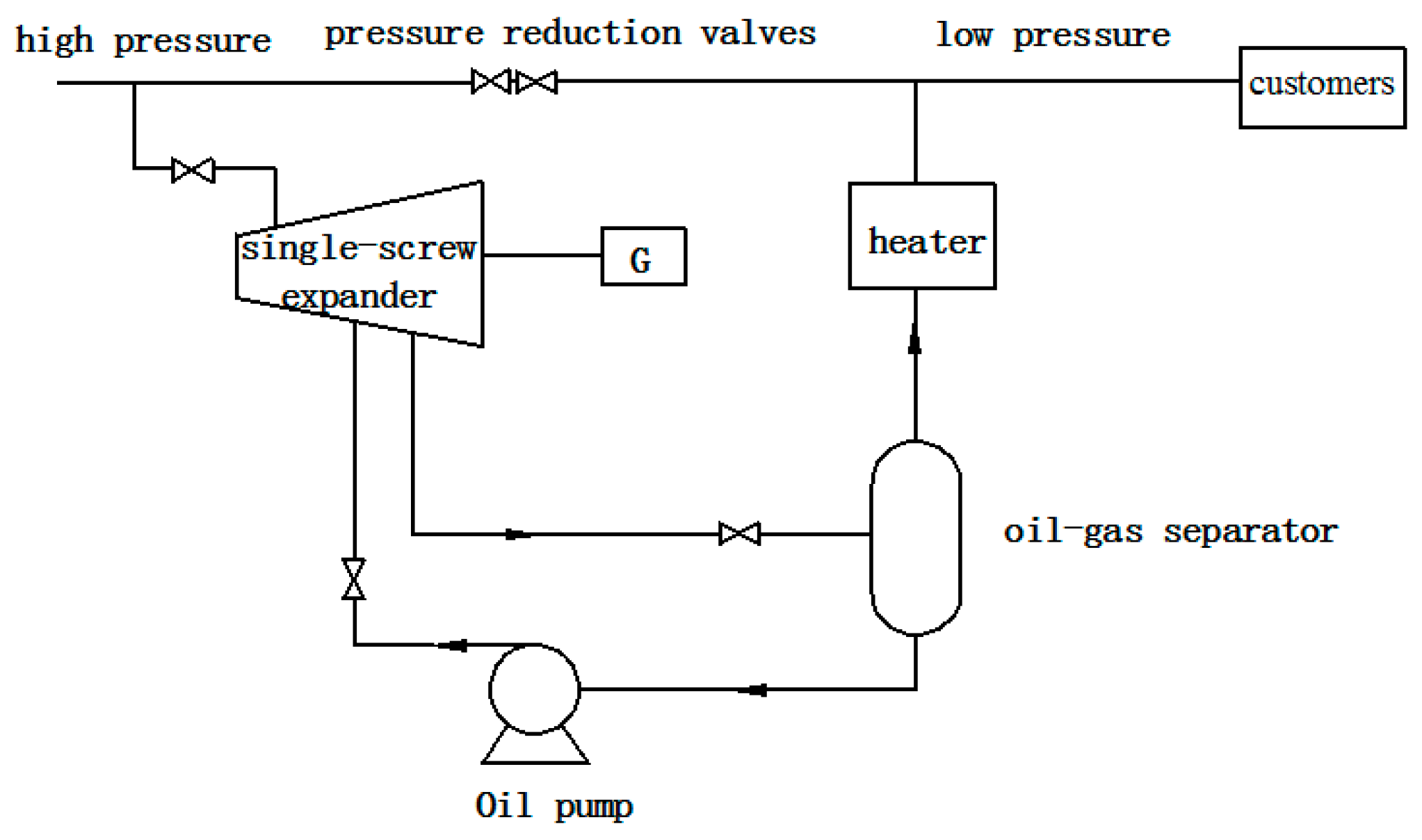

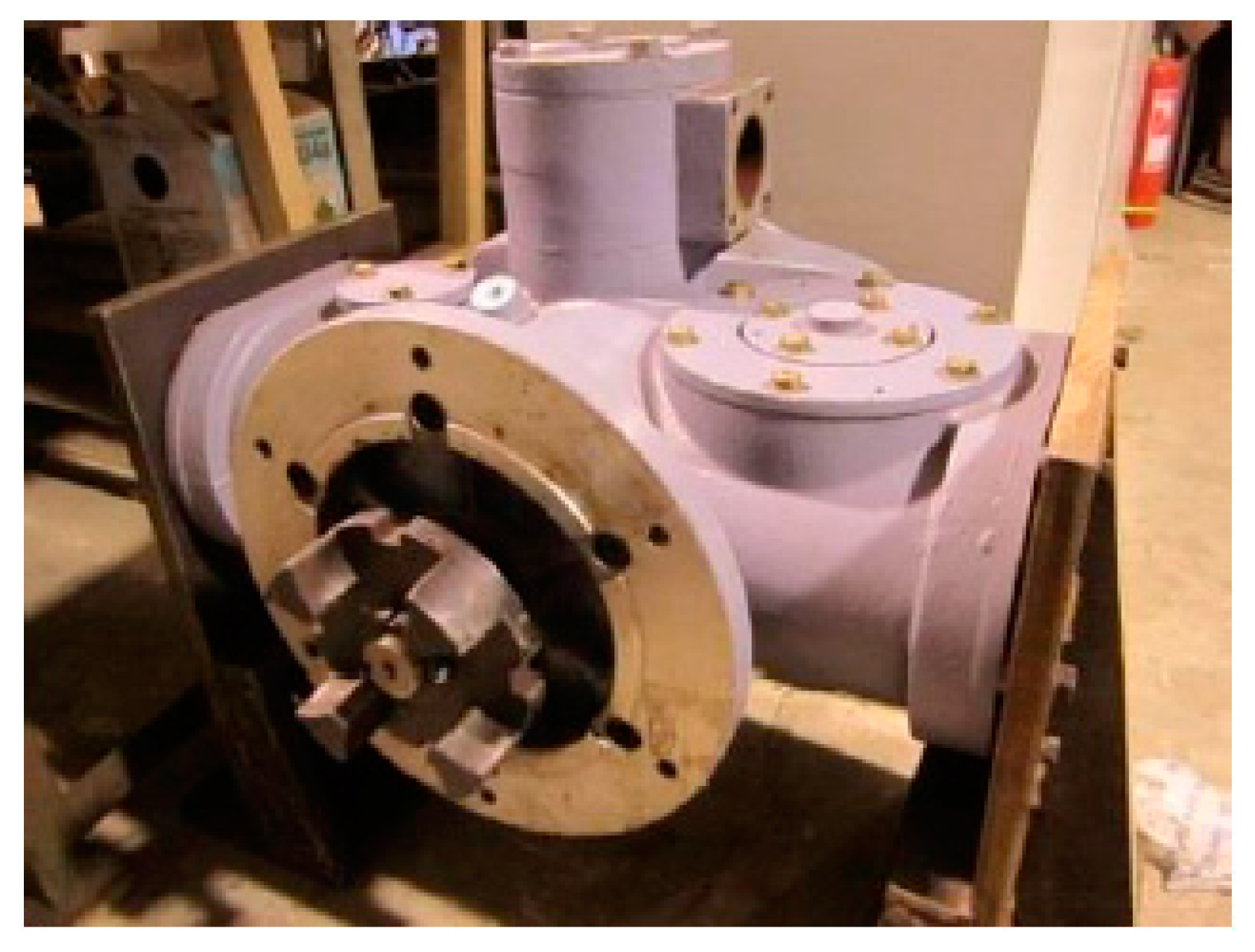
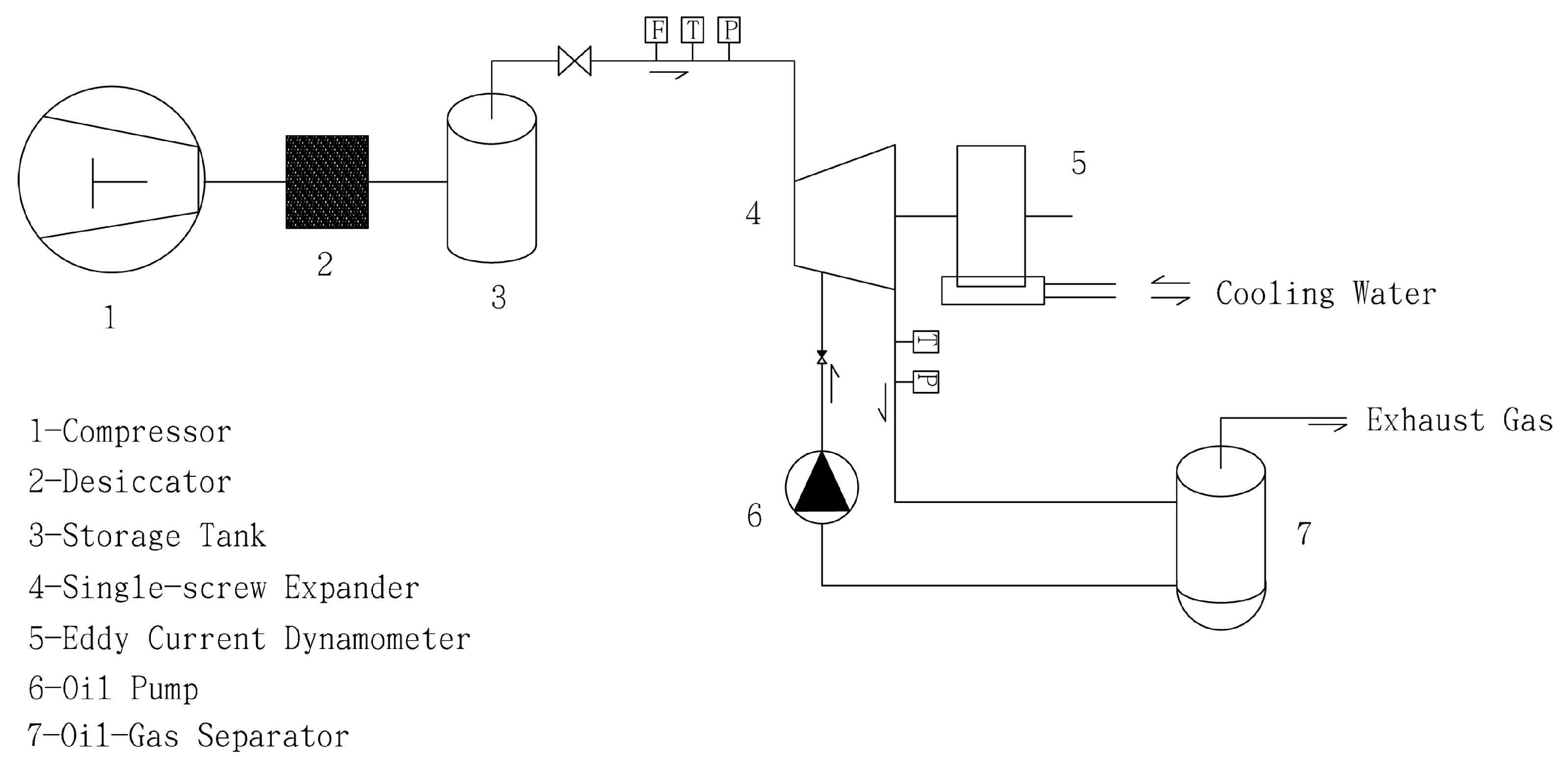
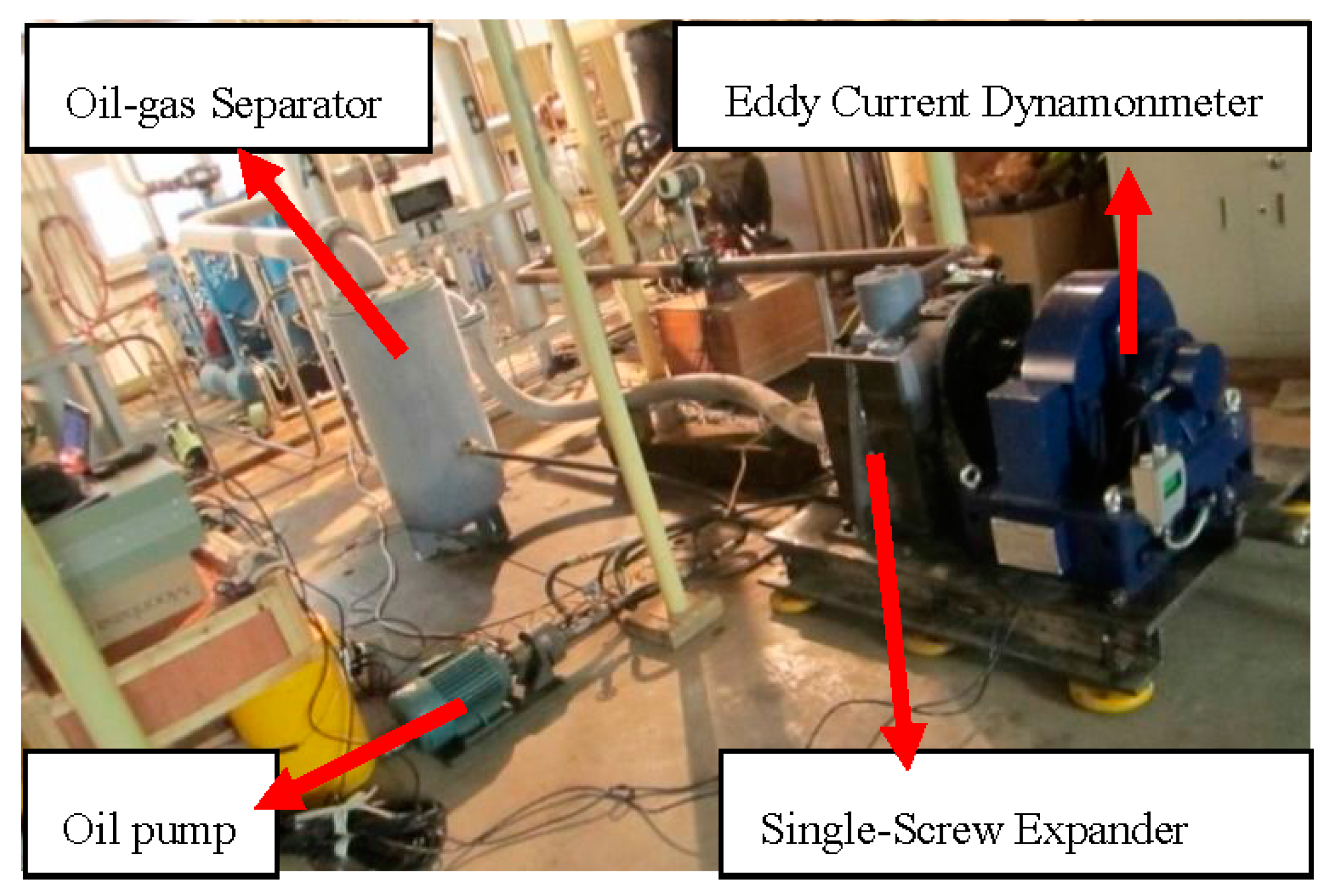
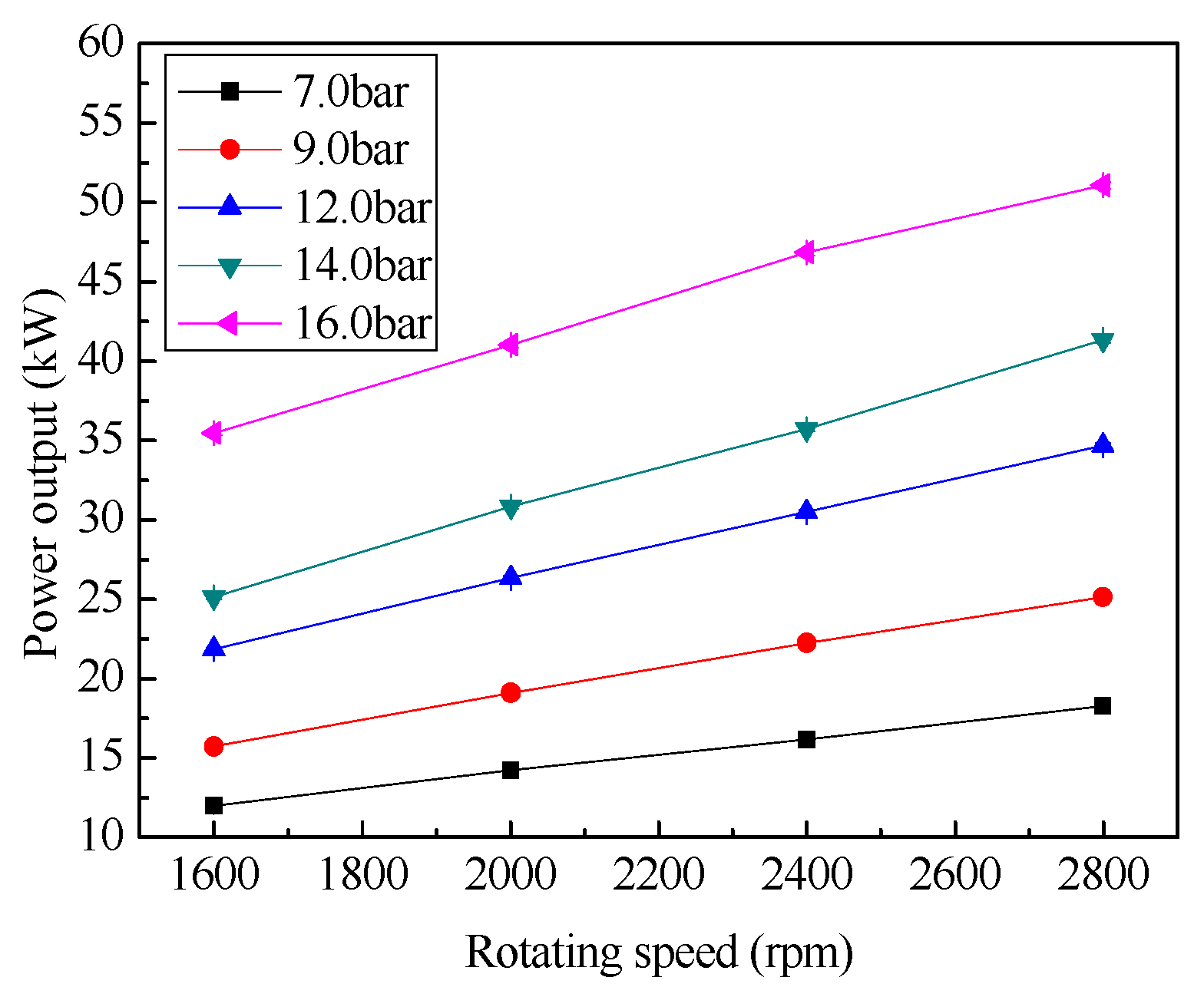
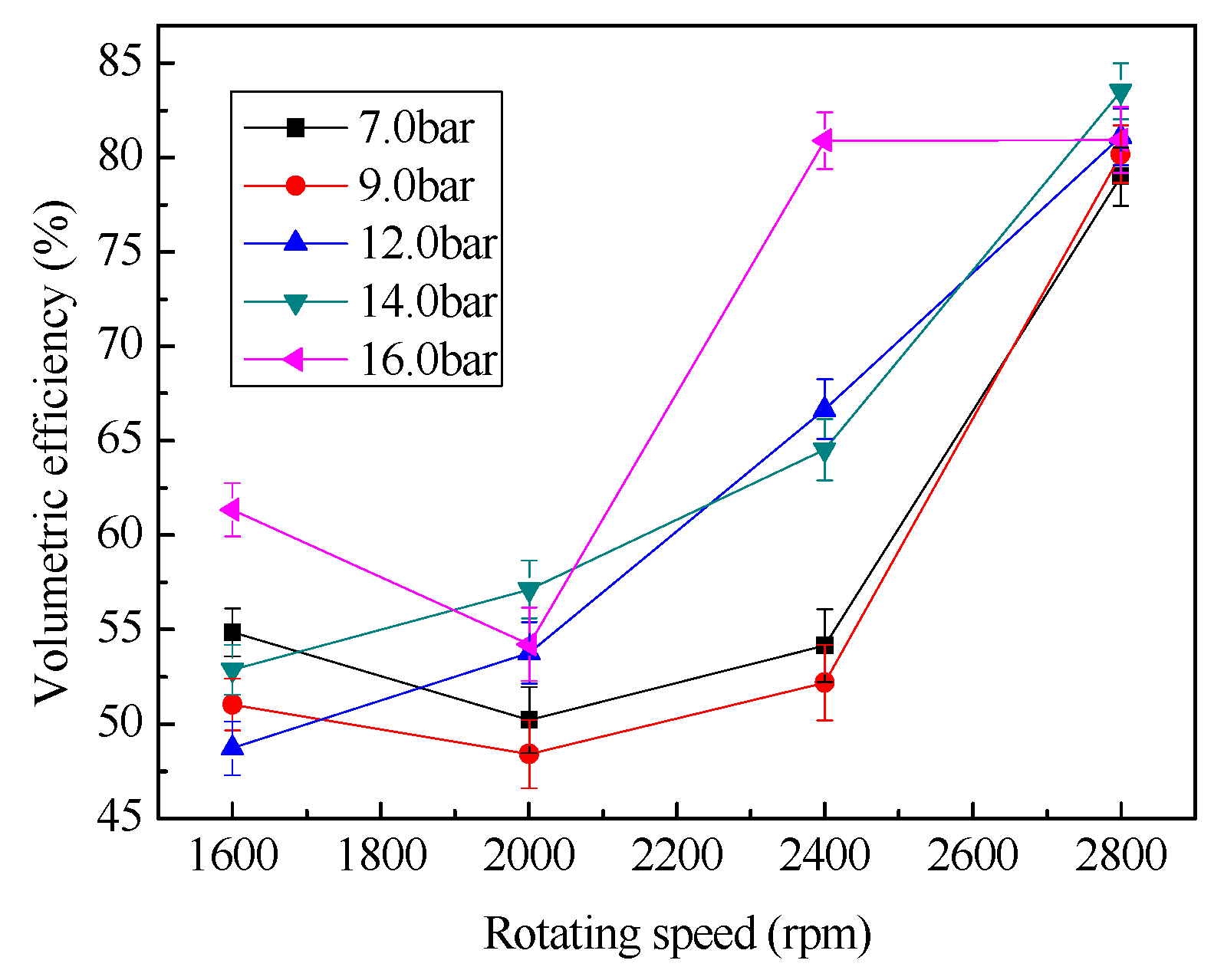
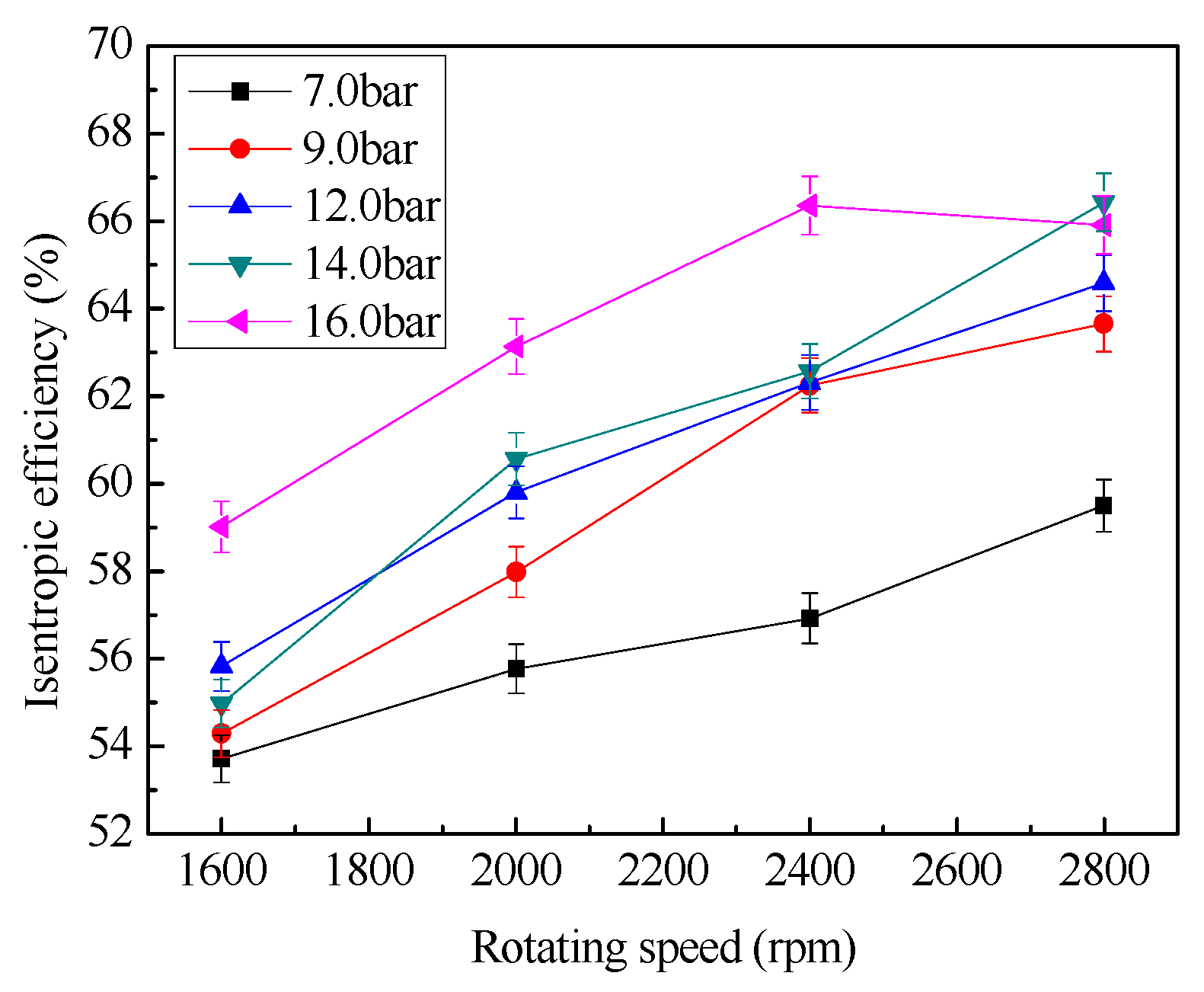
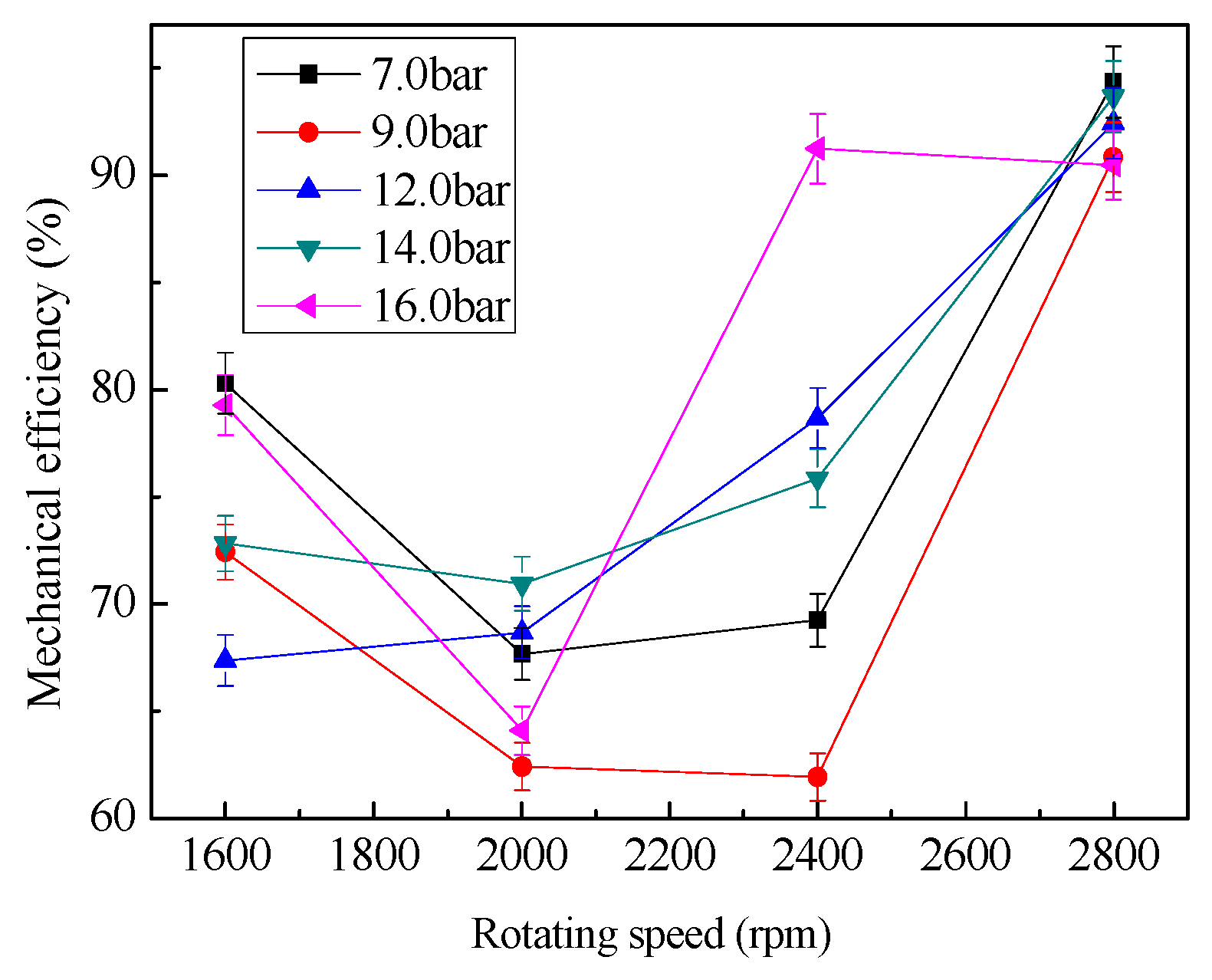
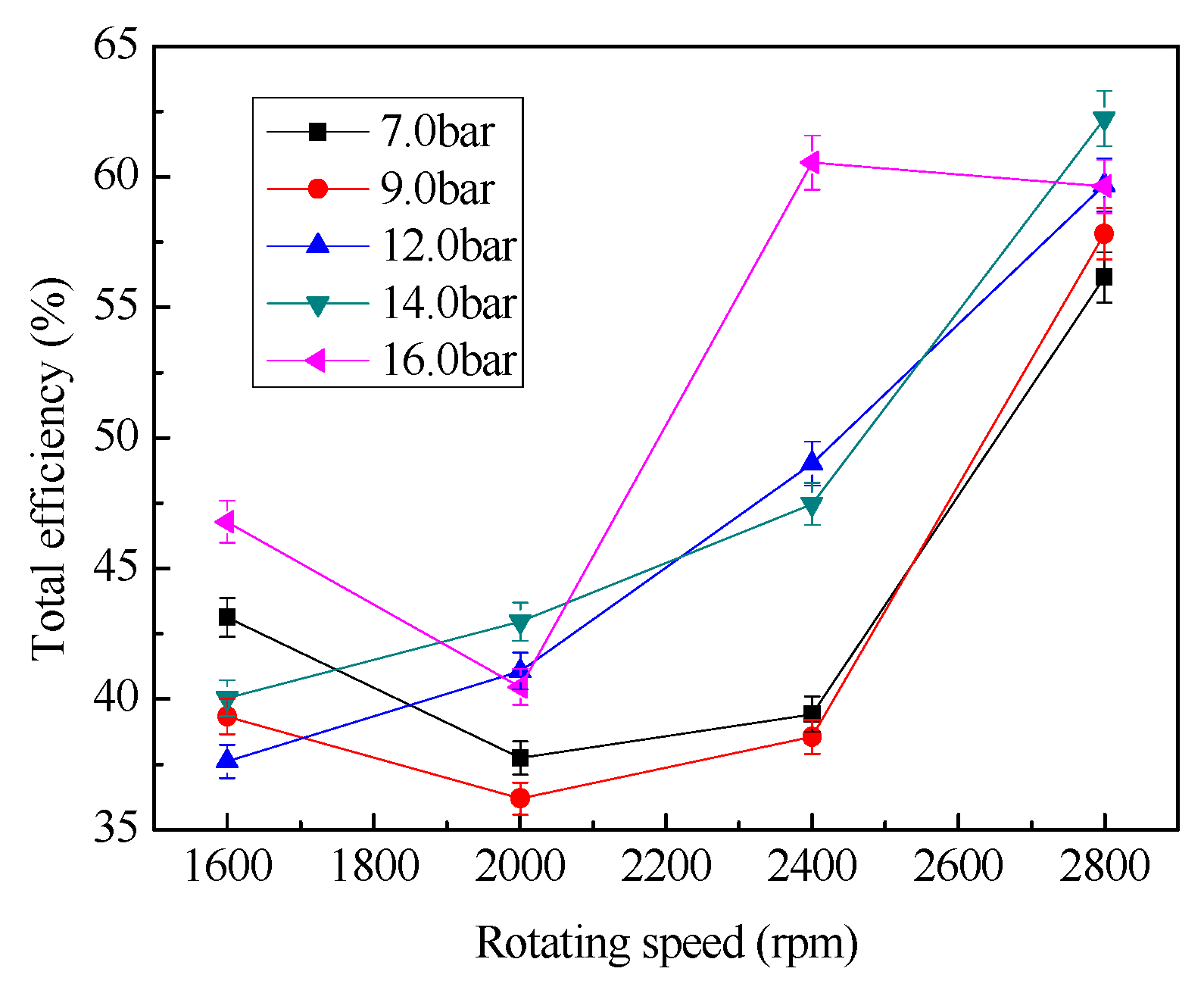
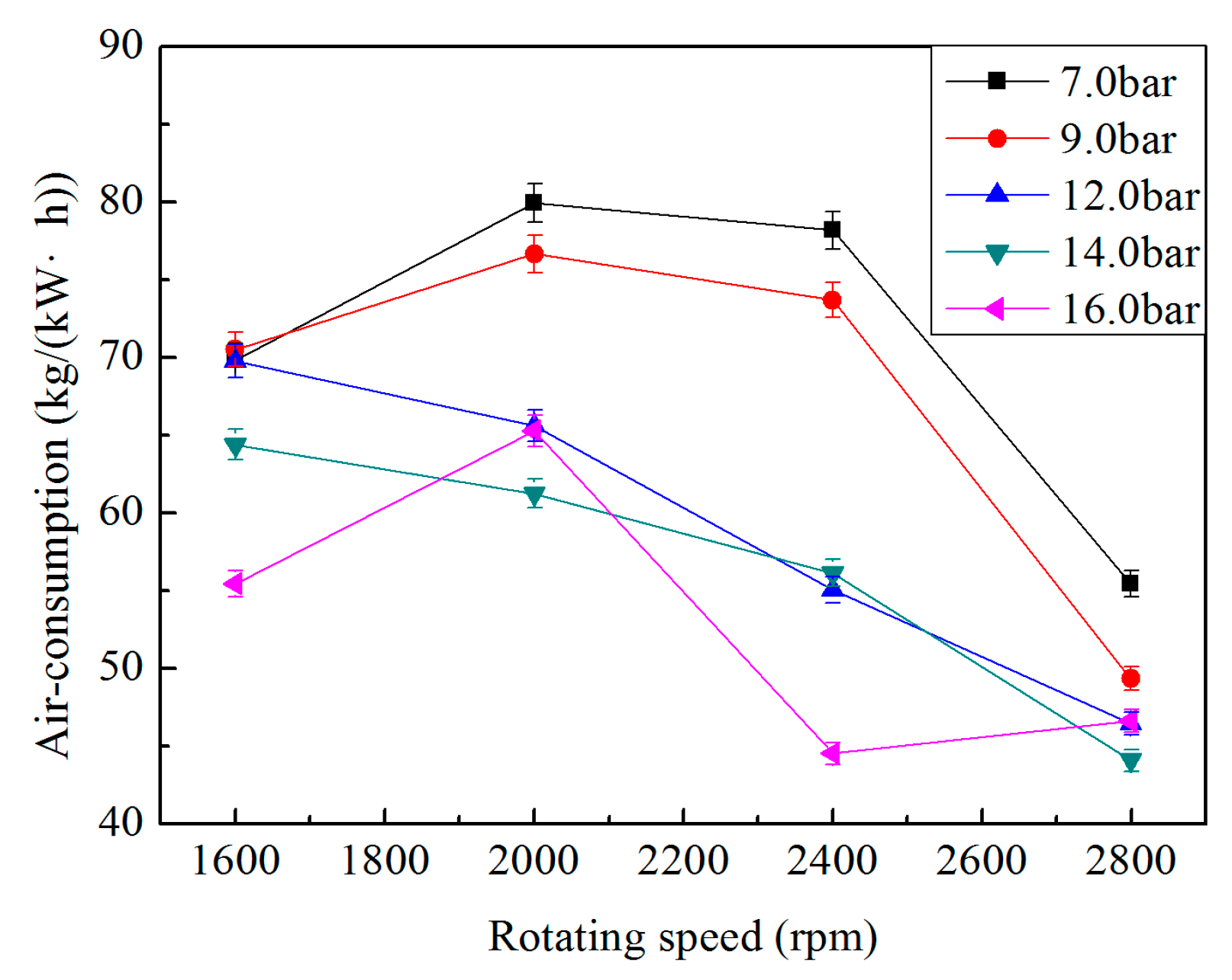
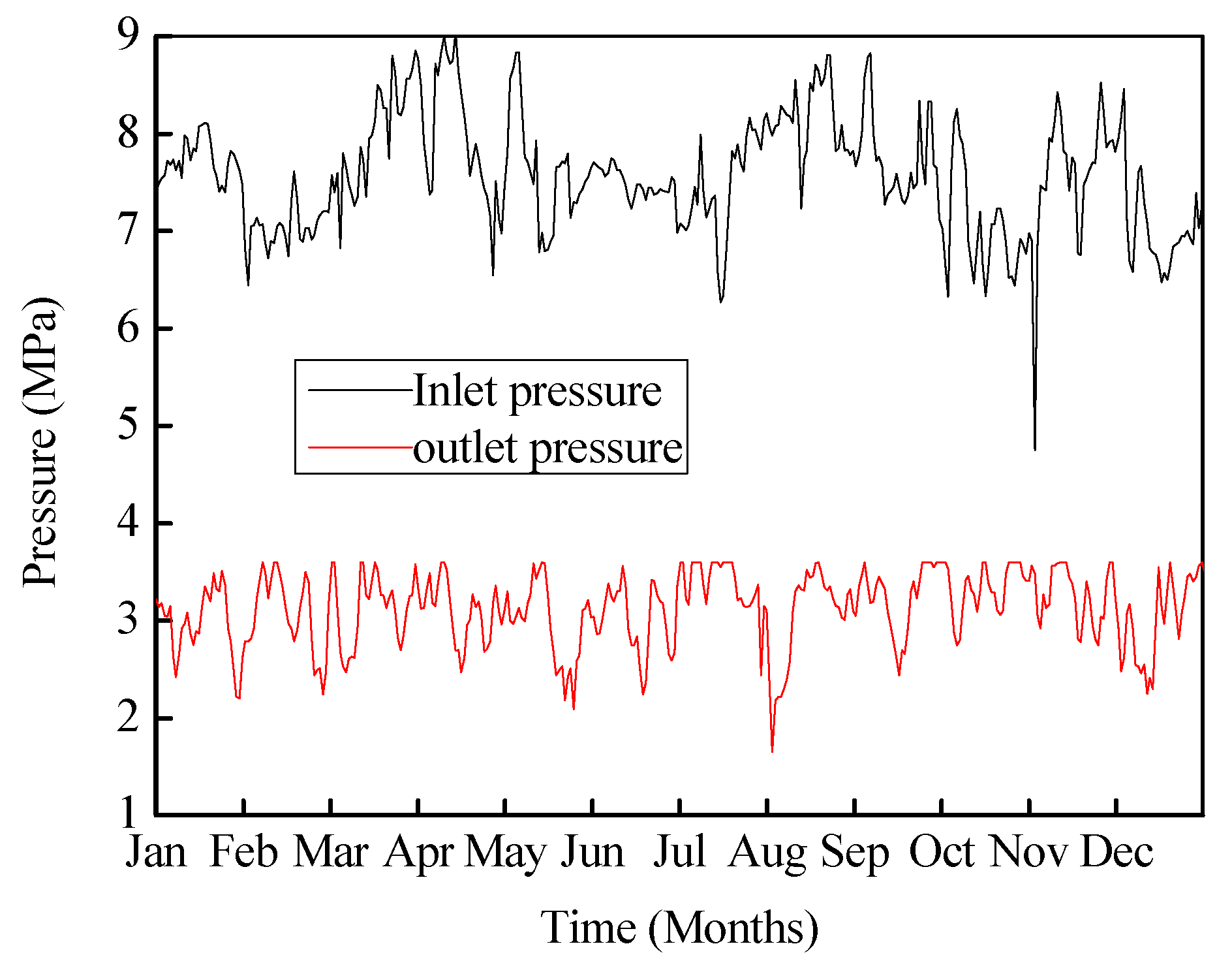
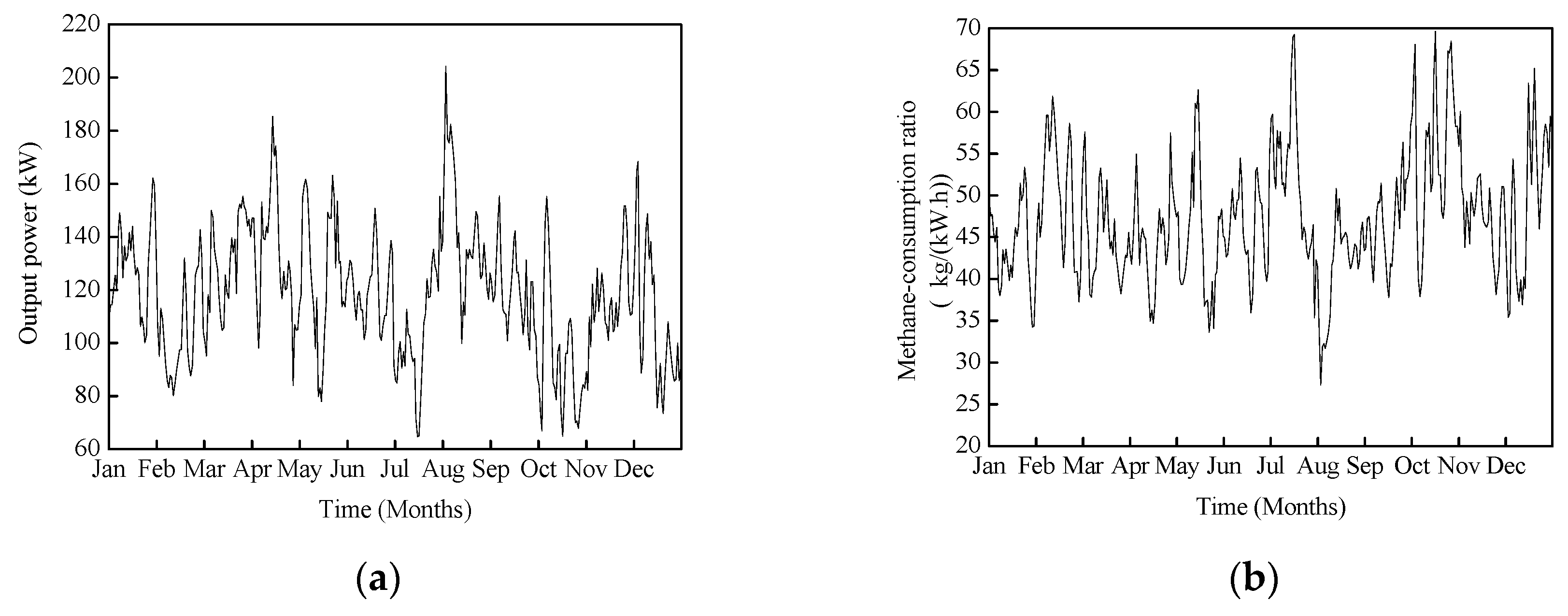
| Parameter | Diameter of the Screw (mm) | Groove Number of the Screw | Diameter of the Gate Rotor (mm) | Tooth Number of the Gate Rotor | Center Distance (mm) | Displacement (dm3/r) |
|---|---|---|---|---|---|---|
| value | 195 | 6 | 195 | 11 | 156 | 29 |
| Value | Output Power (kW) | Methane-Consumption Ratio (kg/(kW·h)) |
|---|---|---|
| Maximum | 204.7 | 69.6 |
| Mean | 118.6 | 47.4 |
| Minimum | 64.7 | 27.3 |
© 2016 by the authors; licensee MDPI, Basel, Switzerland. This article is an open access article distributed under the terms and conditions of the Creative Commons Attribution (CC-BY) license (http://creativecommons.org/licenses/by/4.0/).
Share and Cite
Li, G.; Wu, Y.; Zhang, Y.; Zhi, R.; Wang, J.; Ma, C. Performance Study on a Single-Screw Expander for a Small-Scale Pressure Recovery System. Energies 2017, 10, 6. https://doi.org/10.3390/en10010006
Li G, Wu Y, Zhang Y, Zhi R, Wang J, Ma C. Performance Study on a Single-Screw Expander for a Small-Scale Pressure Recovery System. Energies. 2017; 10(1):6. https://doi.org/10.3390/en10010006
Chicago/Turabian StyleLi, Guoqiang, Yuting Wu, Yeqiang Zhang, Ruiping Zhi, Jingfu Wang, and Chongfang Ma. 2017. "Performance Study on a Single-Screw Expander for a Small-Scale Pressure Recovery System" Energies 10, no. 1: 6. https://doi.org/10.3390/en10010006





